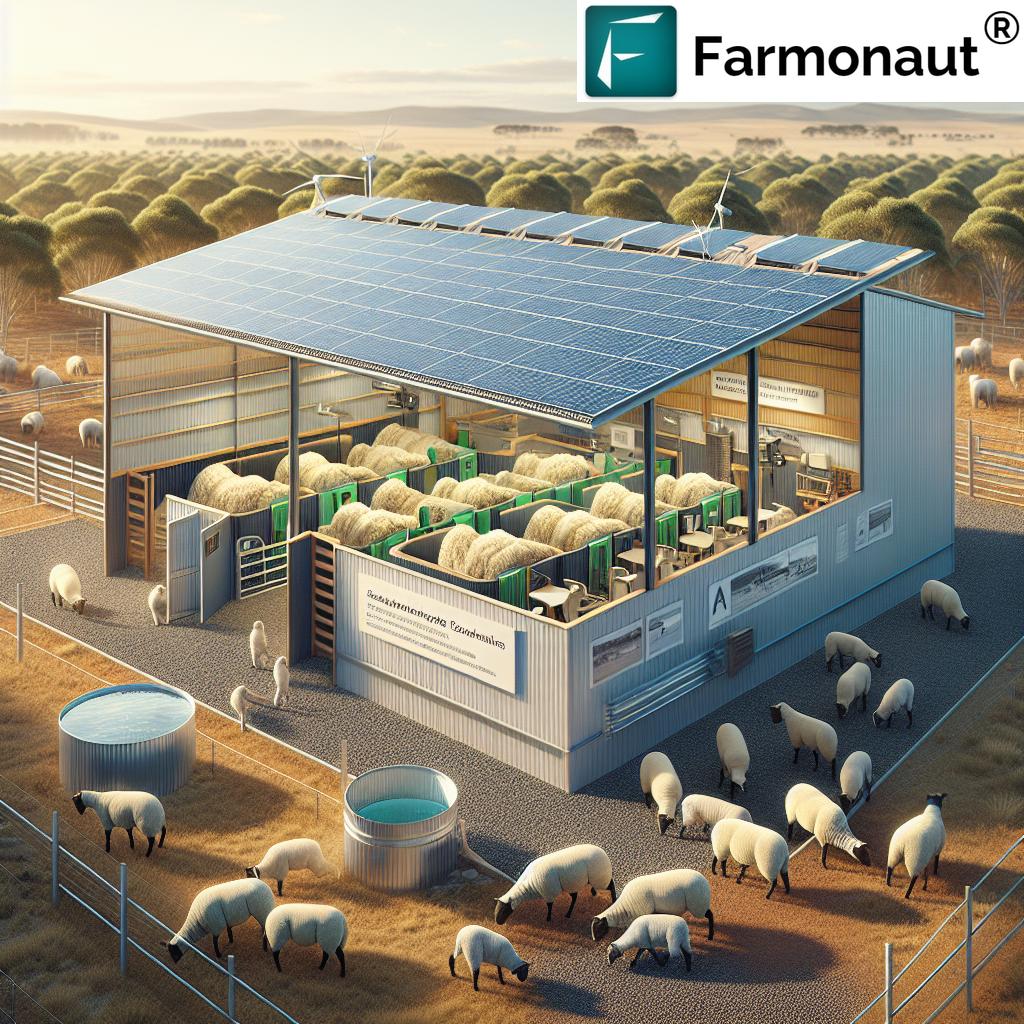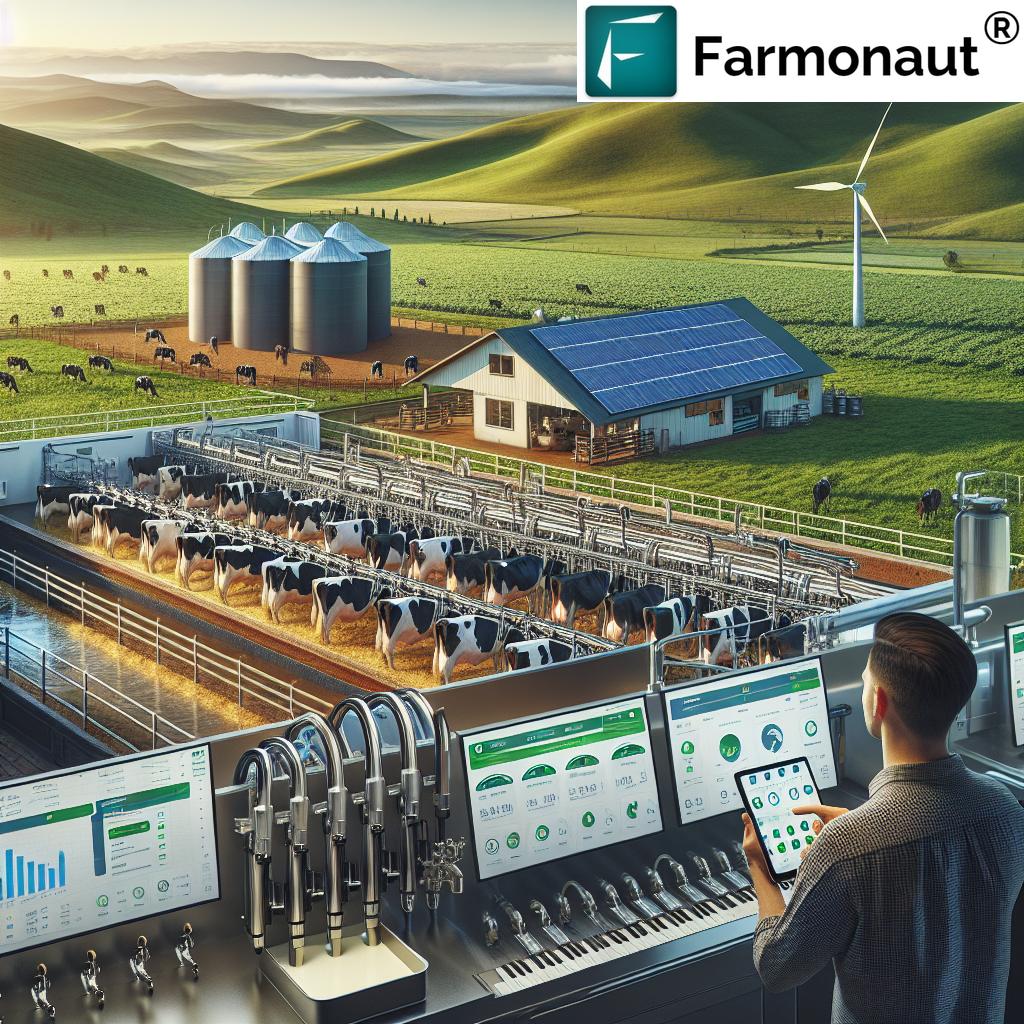New Shearing Shed: 7 Essential Design Tips for Efficiency
Introduction
Designing a modern shearing shed is a pivotal step for any sheep farming operation looking to maximize efficiency, enhance wool quality, and ensure lasting comfort and safety for both workers and livestock. With increasing market demands, strict agricultural regulations, and rapid technological evolution, optimizing your shearing shed design is no longer a luxury—it’s a necessity for operational excellence.
In this comprehensive guide, we’ll explore the 7 essential design tips for building a new shearing shed that meets modern requirements. We’ll address everything from location and effective layout to construction materials, optimal ventilation and lighting, safety features, automation, and sustainable solutions. By following best practices and practical insights, you can ensure your wool-handling infrastructure performs at its very best for years to come.
Did you know? Farmonaut provides advanced satellite-based crop health monitoring, AI-powered advisory, and blockchain product traceability—helping sheep and wool producers optimize productivity, enhance sustainability, and ensure supply chain transparency.
Explore Farmonaut’s API or see our API Developer Docs for powerful farming integrations.
“Modern shearing sheds with optimal layouts can boost wool handling efficiency by up to 30%.”
1. Strategic Location and Efficient Shearing Shed Layout
Why Location and Layout Matter in Shearing Shed Design
The actual placement and layout of your shearing shed dramatically influence workflow, labor costs, and animal handling efficiency. A strategically-placed shed, designed with seamless sheep movement in mind, saves time, reduces stress on livestock, and lowers operational costs.
Key Layout Considerations:
- Proximity to Sheep Housing & Handling Areas:
- Position your shed as close as possible to sheep housing and yards, minimizing the distance sheep need to move—which in turn lessens animal stress and reduces labor hours.
-
Efficient Shearing Shed Layout:
- Adequate sheep flow from catch pens through shearing board and wool handling areas is essential.
- Pathways and gates should be wide enough for easy movement but secure enough to prevent escapes.
-
Optimized Shearing Board Design:
- Spacious shearing boards (minimum height: 3.07 meters and length: at least 12 meters) ensure ease of operation for multiple shearers.
- Allow ample space for handling, shearing, and wool classing without congestion.
-
Catch Pens for Sheep:
- Each pen should hold 12-20 ewes for easy catch and movement.
- Pens must connect intuitively to shearing areas—minimizing worker steps and sheep movement time.
-
Wool Storage Areas:
- Designate separate storage spaces outside the main shearing floor to ensure efficient wool handling and minimal contamination.
A logical, strategic location and an efficient shearing shed layout provide the foundation for all other operational optimizations—helping you reduce labor, boost productivity, and strengthen biosecurity.
2. Shearing Shed Construction Materials & Durability
Choosing the Right Shearing Shed Construction Materials
Material selection directly impacts your shearing shed’s durability, maintenance needs, and long-term operational costs. Given the challenging environmental conditions in many sheep farming regions, using robust materials is crucial for shed longevity and animal (livestock) safety.
Recommended Construction Choices:
-
Steel Structures: Steel shearing sheds remain highly popular—outperforming traditional timber builds in terms of strength, durability, pest resistance (termites), and low maintenance requirements.
- Withstand harsh weather including wind, rain, and temperature shifts.
- Resistant to common agricultural pests.
- Easy to clean, long life expectancy, and generally lower lifetime costs.
-
Modular & Prefabricated Designs: Prefabricated or modular sheds offer quick deployment and flexibility.
- Reduce construction time and labor requirements.
- Offer custom layout solutions—futureproofing for expansion or operational changes.
-
Durable Non-Slip Flooring: Install non-slip, heavy-duty flooring for both sheep safety and worker stability.
- Textured concrete, grooved steel panels, or commercial-grade rubber are common choices.
- Reduces trip hazards and injury risks.
- Weather-Resistant Roofing: Use insulated, corrosion-resistant panels to handle temperature shifts and moisture/humidity.
By selecting appropriate materials, you ensure that your shearing shed will provide reliable protection for livestock and workers—eliminating avoidable maintenance downtime and supporting efficient daily operations.
For operators managing larger, mobile, or multi-location sheep operations,
Farmonaut’s Fleet Management solution
streamlines machinery usage, reducing costs and improving oversight—ideal for optimizing shearing day logistics.
“Proper lighting in shearing sheds reduces worker fatigue by 25%, improving both safety and productivity.”
3. Shearing Shed Ventilation and Lighting
Essential Ventilation and Lighting for Worker Safety and Wool Quality
Poor lighting and inadequate ventilation compromise both wool quality and worker comfort. When designing your modern sheep shearing shed, aim to install systems that enable clear visibility, air circulation, and proper environmental conditions.
- Natural Lighting: Utilize translucent roof and wall panels to allow for diffuse, even daylight, reducing glare and eye strain for shearers.
-
Artificial Lighting: Install fluorescent lights—minimum 250 lux at the shearing board and up to 500 lux at wool classing tables.
- This level ensures that shearers can see their work clearly at all times.
- Well-lit storage, pen, and handling areas are also essential for safety and quality control.
-
Ventilation: Proper ventilation systems will minimize dust, odors, heat, and humidity.
- Open eaves, ridge vents, and wall louvres promote continuous airflow.
- Reduces condensation—critical for improving wool quality and eliminating respiratory discomfort.
By creating optimal ventilation and reliable lighting conditions, you protect worker health and maximize productivity during demanding shearing periods.
Tip: Good airflow and natural lighting also support
carbon footprint reduction strategies,
cutting energy usage and advancing sustainable shearing shed solutions.
4. Shearing Shed Safety Features and Worker Well-being
Critical Shearing Shed Safety Features to Prevent Accidents
Shearing can be physically demanding and repetitive, so safeguarding both workers and livestock with specific safety features is essential. Injuries negatively impact morale and operational efficiency, making prevention a top design objective.
-
Guard Rails and Fencing:
- Guard rails should border all raised work platforms or shearing boards.
- Properly installed rails and fencing in sheep holding areas prevent falls and contain livestock securely.
-
Non-Slip Flooring Materials:
- Durable, textured floors keep both people and animals safe—especially in areas frequently wet from washing or wool processing.
- Use materials rated for livestock traffic to ensure long-term slip resistance.
-
Emergency Facilities:
- Install first aid kits in visible, quickly accessible locations near shearing stations.
- Fire extinguishers and clear emergency exit routes must comply with local agricultural safety regulations.
Minimizing safety hazards also lowers insurance claims and boosts worker satisfaction—key contributors to sustainable farm productivity.
Interested in full supply chain transparency and responsible wool marketing?
Learn about Farmonaut’s blockchain-based product traceability solution
—track your wool from farm to final buyer, ensure authenticity, and build market trust.
5. Integrating Automated Shearing Systems & Technology
Boost Productivity with Automated Shearing Systems and Smart Technology
Modern sheep shearing sheds can be dramatically optimized by integrating technology and automation—transforming traditional workflow, reducing labor costs, and supporting truly efficient operations.
-
Mechanical Shearing Equipment:
- Mechanical shearing units (including tractor-pulled or mobile platforms) enable multiple shearers to work simultaneously, increasing productivity and consistency.
- Reduces the number of staff required during peak shearing time.
-
Automated Systems:
- Automate lighting, ventilation, and even sheep movement or sorting using programmable control systems.
- Automated record-keeping for animal handling tasks and wool output streamlines reporting and traceability.
-
IoT and Digital Connectivity:
- Smart sensors and wireless controllers can provide alerts (for shed conditions or security) directly to your device.
- Data collected can inform better decisions about shed maintenance or layouts in the future.
Managing multiple sheds or broadacre sheep enterprises?
Farmonaut’s Large-Scale Farm Management platform offers integrated monitoring and operational analytics for the whole farm—perfect for centralized oversight and reducing costs through data-driven decision making.
6. Sustainable Shearing Shed Solutions & Environmental Considerations
Creating an Environmentally Responsible Shearing Shed
Sustainability is integral to any modern shearing shed design. As environmental requirements evolve, it’s vital to incorporate systems that reduce your carbon footprint, save energy, and futureproof the operation.
- Insulation: Use insulated panels and construction materials to maintain comfortable internal temperatures, reduce reliance on heating/cooling, and save on energy costs.
- Rainwater Harvesting: Install rainwater collection systems on shed roofs for cleaning, stock watering, or shed irrigation.
-
Solar Power Integration:
- Install solar panels to generate electricity for lighting, automation systems, or backup power—lowering operating costs.
- Many governments now incentivize solar upgrades for agricultural facilities.
Incorporating these sustainable shearing shed solutions offers both environmental and direct operational benefits—reducing bills and supporting responsible animal welfare.
Farmonaut’s crop loan and insurance services also help farmers access critical funding faster—with satellite-based field verification reducing risk and costs for both borrowers and lenders.
7. Compliance, Regulations & Shearing Shed Best Practices
Meeting Legal Standards and Industry Requirements
No shearing shed design is complete without conformity to local and national agricultural standards. A compliant shed improves biosecurity, livestock welfare, and long-term business sustainability.
-
SafeSheds Program:
- Refer to resources like the SafeSheds program (see SafeSheds here) for best-practice guides, safety checklists, and practical improvement plans.
-
Consultation and Expert Input:
- Engage agricultural engineers, architects, and experienced shearers during the design process to ensure compliance, functionality, and future-proofing.
- Seek guidance on site selection, worker safety, workflow, and animal comfort to optimize results.
Thorough compliance not only satisfies regulations, but protects you against liability and supports a positive farm reputation—especially when selling into premium wool markets.
Design Element Comparison Table
A strong design guide isn’t complete without at-a-glance comparisons for each design element in your shearing shed. Use the table below to weigh recommended standards, costs, efficiency, and essential safety features:
| Design Aspect | Recommended Option/Standard | Estimated Cost Range (USD/sq m) | Efficiency Impact | Safety Benefit |
|---|---|---|---|---|
| Flooring | Non-slip grooved concrete or textured steel/rubber |
$35–$65 | High (Trip hazard risk down by 80%) |
Yes (Falls/injury reduction) |
| Lighting | Natural translucent panels + Fluorescents (250–500 lux) | $15–$30 | High (25% less worker fatigue) |
Yes (Improved visibility) |
| Ventilation | Ridge vent, louvres, open eaves | $8–$18 | Medium (Up to 30% wool quality boost) |
Yes (Reduces heat/humidity) |
| Materials | Steel frame, modular prefabricated panels | $65–$140 | High (Lifespan 2x timber) | Yes (Pest/termite resistance) |
| Safety Features | Guard rails, fencing, emergency kits/routes | $10–$22 | Medium | Yes (Major injury risk down) |
| Automation | Automated shearing, smart lighting and ventilation | $80–$200* | Very High (Up to 50% labor saving possible) |
Partial (Reduces operator error) |
| Environmental | Insulation, solar panels, rainwater harvesting | $25–$80* | Medium-High (Long-term energy savings) | Yes (Reduces heat/cold stress) |
*Cost for automation and renewables varies by system complexity & shed size.
Cost Considerations & Return on Investment
While investing in a new shearing shed can result in a substantial upfront outlay, the operational benefits and increased productivity quickly offset costs:
-
Increased Efficiency:
- A modern, well-designed shed can double the number of sheep shorn each day (see ABC News).
-
Enhanced Worker Satisfaction & Retention:
- Safer, more comfortable working conditions reduce staff turnover and attract skilled shearers.
-
Improved Wool Quality:
- Clean, dry, and specialized wool classing areas lead to higher graded wool—maximizing market price.
-
Long-Term Durability:
- Using steel and durable panels eliminates costly repairs and reinvestments seen with some traditional wooden sheds.
The payback period for a modern sheep shearing shed is often less than 5 years, depending on operational scale and market prices for premium wool.
Leveraging Farmonaut Technology for Modern Sheep Operations
In today’s competitive agricultural sector, integrating digital farm management can take your shearing shed and overall farming operations to the next level. At Farmonaut, our mission is to make precision agriculture affordable and accessible globally through:
- Satellite-based health monitoring of grazing pastures, allowing real-time detection of feed quality changes.
- AI-powered advisory systems (Jeevn AI) for weather, disease predictions, and tailored livestock management insights.
- Blockchain-based product traceability to maintain full transparency and market trust from farm to fabric.
- Fleet and resource management to optimize the movement and efficiency of machines during shearing days.
- Carbon footprint tracking to support your environmental commitments and unlock sustainability certifications/markets.
All these services are available via our mobile apps (Android, iOS), web portal, and API, empowering sheep farmers to make smarter, more profitable, and sustainable choices.
Ready to unlock the future of wool production?
Get started with Farmonaut’s farm management platform today!
FAQ – Shearing Shed Design & Efficiency
Q1: What is the ideal size for a shearing shed?
An efficient shearing shed design typically features a shearing board at least 12 meters long (excluding wool storage), with a minimum height of 3.07 meters. The number of stands and holding pens will depend on flock size and peak throughput goals.
Q2: Which materials last longest in shearing shed construction?
Steel and modular prefabricated panels are increasingly popular due to exceptional durability, low maintenance, and resistance to pests and weather extremes.
Q3: How can I improve safety in my shearing shed?
Install guard rails, non-slip flooring, emergency exits, and accessible first aid kits. Follow SafeSheds guidelines for optimal safety practices.
Q4: Is natural or artificial lighting better for sheds?
The best approach is a combination: translucent roof panels maximize natural light, while well-placed fluorescent lights (250-500 lux) maintain safe conditions under all weather.
Q5: Can sheds be upgraded for sustainability?
Yes! Add insulation, rainwater harvesting, and solar panels—which offer long-term energy and water savings, plus environmental compliance.
Conclusion
Constructing a new shearing shed is a multifaceted task that impacts every element of your sheep farming business. Prioritizing strategic location, robust materials, sophisticated ventilation and lighting, a solid foundation of safety features, judicious automation, and long-term sustainability will guarantee a facility that’s productive, safe, and future-ready.
Applying these 7 essential design tips helps maximize operational efficiency, drive down labor requirements, and deliver consistently high-grade wool. And with precision tools from Farmonaut—including satellite monitoring, AI advisory, and supply chain traceability—you can take your sheep operations, wool brand, and farming profitability to new heights.
Ready to revolutionize your sheep farming? See how Farmonaut’s easy-to-use platform delivers actionable insights, resource management, and cutting-edge digital tools for your operation.















